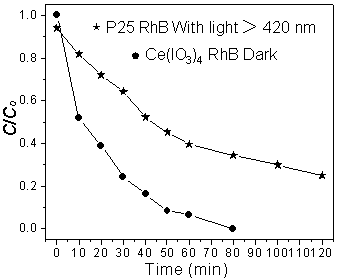Application of ce(io3)4
A technology of pollutants and organic dyes, applied in the field of environmental pollution control, can solve problems such as inability to show catalytic activity, limited application of catalysts, weak light intensity, etc., and achieve the effects of being conducive to popularization and application, mild preparation conditions, and simple preparation methods
- Summary
- Abstract
- Description
- Claims
- Application Information
AI Technical Summary
Problems solved by technology
Method used
Image
Examples
Embodiment 1
[0021] (1) Ce(IO 3 ) 4 preparation of
[0022] 1 mmol ammonium cerium nitrate ((NH 4 ) 2 Ce(NO 3 ) 6 ) 40 mL deionized water to obtain cerium ammonium nitrate solution. 4mmol of sodium iodate (NaIO 3 ) was dissolved in 40 mL deionized water to obtain a sodium iodate solution. While stirring the sodium iodate solution, ceric ammonium nitrate was added dropwise to the sodium iodate solution at room temperature. After the dropwise addition was completed, stirring was continued for 1 h. The obtained precipitate was washed twice with deionized water (50 mL of deionized water each time), and after centrifugation, it was dried in an oven at 60 °C for 12 h to obtain Ce(IO 3 ) 4 sample.
[0023] (2) Ce(IO 3 ) 4 representation of
[0024] From figure 1 The SEM image shows that Ce(IO 3 ) 4 The sample has random morphology with a size of 0.1-10 nm. figure 2 The EDS result of the SEM figure shows that the contained atoms Ce, I, O number ratio of the sample is close to 1:...
PUM
 Login to View More
Login to View More Abstract
Description
Claims
Application Information
 Login to View More
Login to View More - Generate Ideas
- Intellectual Property
- Life Sciences
- Materials
- Tech Scout
- Unparalleled Data Quality
- Higher Quality Content
- 60% Fewer Hallucinations
Browse by: Latest US Patents, China's latest patents, Technical Efficacy Thesaurus, Application Domain, Technology Topic, Popular Technical Reports.
© 2025 PatSnap. All rights reserved.Legal|Privacy policy|Modern Slavery Act Transparency Statement|Sitemap|About US| Contact US: help@patsnap.com



